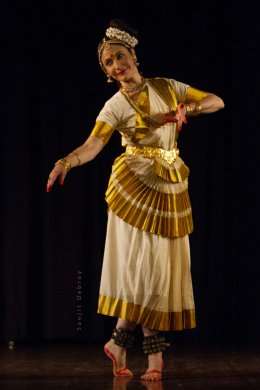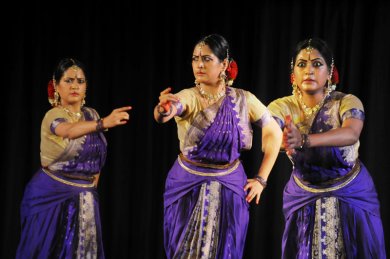
|   |

|   |
 e-mail: leelakaverivenkat@gmail.com Indian dance as part of the world cultural community Photos courtesy: Manasa August 16, 2018 In the three-day festival of Manasa- Art Without Frontiers 'On looking back to move forward' one of the morning panel discussions pertained to Indian Classical Dance Transnationally. Though the point was not discussed, one realizes that in many countries of the west, Indian dance has a fringe presence particularly in the main festivals and that its high activity is restricted to the Indian diasporic circles, particularly in the States and the U.K. But this is not the situation in all countries and that our dancers are constantly vying with one another to be sent on tours by the ICCR for participation in festivals, is well known. As part of the world cultural community, the discussion featured Rama Vaidyanathan and Arshiya Sethi, and the person who was supposed to be on the panel Riva Ganguly Das, the ICCR DG, was not present. The session had Ambassador Amarendra Khatua as moderator. Now, as part of the World Cultural Community, there are over 7600 schools teaching Indian dance forms abroad was what Ambassador Amarendra Khatua mentioned. Speaking of performing abroad, much travelled Rama Vaidyanathan emphasized the responsibility of being "reflectors of the culture of a country" and projecting oneself as a forward thinking, liberated, cultural face of the country, because "what they see is what we stand for". Speaking in reference to European countries where one has less mainstream Indian dance than in America, Rama said that her discovery was that more than rhythmic power and virtuosity, it is emotive power in the dance which helps establish the connect with the audience (Strange for a dancer like Rama who is known for her exceptional nritta to say so!). And here, she considered that ICCR's role plays a very important part. According to her the biggest challenge lies in 'having to stay inspired'. Arshiya Sethi's contribution was a painstaking information-packed lecture (which had to be unfortunately cut short due to lack of time) on how Indian dances came to be known in the States and today it is mainstream art. Starting with the Asia Pavilion in the World Fair, and Luna Park Coney Island, Amusement Park (1904) where scenes of Delhi were created, to great choreographers inspired by Indian images like Ruth St Denis and Ted Shawn, La Meri, and finally Ragini Devi who learnt Indian dance forms and later we had Ram Gopal and many more, Arshiya's talk packed data with some rare video clips, which she had been able to access during her year long stay in the States. One awaits a book by her containing all this priceless information she has acquired. While a lot of scattered information on individuals is available, a detailed account on this subject giving a total view of all the artists, has not been written by any Indian and it would form a valuable part of any Indian library. Non-Indians taking to Indian dance forms as a way of life is an aspect touched upon in one of the sessions. On the panel was Carolina Prada, Mayurbhanj dancer who spoke on how after being drawn to Odissi, she had discovered that her heart was more with Chhau. The initial years were tough, for foreigners do get exploited at times (and this is one aspect many of us have been aware of) and she had to prove that her interest in the dance was more than a passing touristy flash. For French Brigitte Chataignier, Kerala and Kalamandalam were the constant beckoning factors. Her intense involvement with Mohiniattam finally led to her setting up Prana company for teaching the dance in Paris - her interaction with gurus has continued through frequent Indian visits. The love for Bharatanatyam has made Justin McCarthy make his home in India - for long now heading the Bharatanatyam faculty at the Bharatiya Kala Kendra. He mentioned that the 'guru' title was highly embarrassing, for he would prefer the word 'teacher'. All the panelists expressed displeasure at the 'foreigner' and 'Videshi Kalakar' tags, while also mentioning that the word 'alien' used in countries like the United States was worse. There was little time to discuss any point at length, but this is a subject which can raise issues. I remember asking Guru Kelucharan Mohapatra if he had a special technique while teaching Odissi to non-Indians. He immediately said, "For me the person is a student like any other and has to be taught." He did not deny that it is ultimately a question of hailing from a different culture and dance does represent one's culture, with specific languages, images, symbols, body technique, music, content et al. When every aspect is different, success lies, to the extent, one hailing from another background makes this one's own language of expression. Nobody discusses the question of 'cultural memory' a body has. We often speak of 'vaasna' in reference to the lingering legacy of cultural inclinations from a past birth - when one from a different culture takes to our own culture without any hiccups. After years of learning, one at times sees dancers from another cultural background move differently - by which I am not referring to grammatical correctness of technique but what can only be called a cultural otherness which defies description. One can fully understand though, that after all the hard work, always being regarded as the 'other' is not a happy feeling.  Brigitte Chataignier The selection of dancers presented during the festival could not be faulted. The performance curtain-raiser was by Brigitte Chataignier, scrupulously grounded in the slow-spun mesmerizing magic of Mohiniattam imbibed from her gurus Leelamma and Kalamandalam Satyabhama. After invocation to Ganapati, rendition of the vintage varnam in Todi, "Dani Samajendra Damini" was unforgettable, Venkateshwaran's evocative singing as special as the dancer's poise in holding moments at ati vilambit pace, portraying the love-struck nayika pining for Sri Padmanabha. Exquisitely lilting in poetic metaphor was Iraiyiman Tampi's lullaby 'Omanatingal' in Kurinji, portraying the mother's vatsalya, lulling her child to sleep. It made the entire audience sway to the music and Brigitte's evocative vatsalya. In a contrasting tone, with a very contemporary sensibility came the Contemporary Dance flowing out of a Mohiniattam, Kaikottikali base- this was an aspect that had a special workshop arranged by Alliance Francaise, in their premises. Truly magical was the special abhinaya evening, directed by Kamalini Dutt with all her years of experience as dancer, teacher and Doordarshan producer, along with Sharon Lowen. Carolina Prada harnessing Mayurbhaj Chhau presented "The Myth of El Dorado" woven round the gold lust which lured Europeans of all races, exploring for the city of gold. Carolina's strong Mayurbhanj Chhau gait and moves led a group of less proficient students who however made up with their involvement. Divya Goswami's Kathak interpretation of early 20th century poet Jaishankar's 'Beeti Vibhavari Jaagri' urging her sleeping friend to wake up and experience the beauty and joy of the new dawn breaking with its message of hope, was laudable as much for the abhinaya depth as for the unobtrusive nritta footwork, sensitively spun in towards the finish. Shibdas Banerjee's agony at the partition of Bengal "Ganga Amar Ma" later echoed by Assam's singing poet Bhupen Hazarika, interpreted by Bharatanatyam dancer Tanya Saxena had some suggestive moments expressing the absurdity of this unnatural division while watching the soaring bird in the sky flying over the horizon and the boat crossing the flowing river waters through the area which is now "Epar, Opar, Dwipara...Janeena." Ramakant Shukla's modern Sanskrit poem "Kroora Hridaya Megha" saw young dancer Katyayani Gupta, whose appeal to the indifferent cloud to bless the arid area with rain for the good of all life, needed more passion, though her nritta in the Tillana finish was good.  Purvadhanashree Purvadhanashree with her Vilasini Natyam training in abhinaya, created an intense narrative based on modern Telugu poet Dr.Devulapallai Venkatakrishna Sastri's 'Puvuvulu Patta,' a flower song. Evoking different moods, first comes the fragrant Jasmine woven into a garland as the symbol of love by the wife for her husband, changing to the martial tone heralding the crimson Hibiscus, the flower for Devi worship, while the purity of selfless devotion takes over with the insignificant grass flower - auspicious for worshipping Ganesh. The music by Sridhar Vasudevan, a rework of Chitaranjan's original, in ragas Pahadi (Jasmine), Madhuvanti (Mandara) and Dhanashree (grass flower) added to the impact. The icing on the cake was Dr. Sridhar Vasudevan himself taking on "Layittavan Kadhai," a Tamil poem by Ravi Subramanian, enjoying himself playing God creating the creatures of the world, swimming, crawling, leaping, galloping, till Man, the acme of His skills is created - and a mesmerized God closes his eyes - which are yet to open and see what Man is doing to Man! With imaginative background sounds, the item demonstrated the artist's versatility.  Writing on the dance scene for the last forty years, Leela Venkataraman's incisive comments on performances of all dance forms, participation in dance discussions both in India and abroad, and as a regular contributor to Hindu Friday Review, journals like Sruti and Nartanam, makes her voice respected for its balanced critiquing. She is the author of several books like Indian Classical dance: Tradition in Transition, Classical Dance in India and Indian Classical dance: The Renaissance and Beyond. Post your comments Please provide your name and email id when you use the Anonymous profile in the blog to post a comment. All appropriate comments posted with name & email id in the blog will also be featured in the site. |